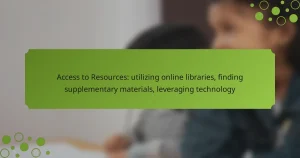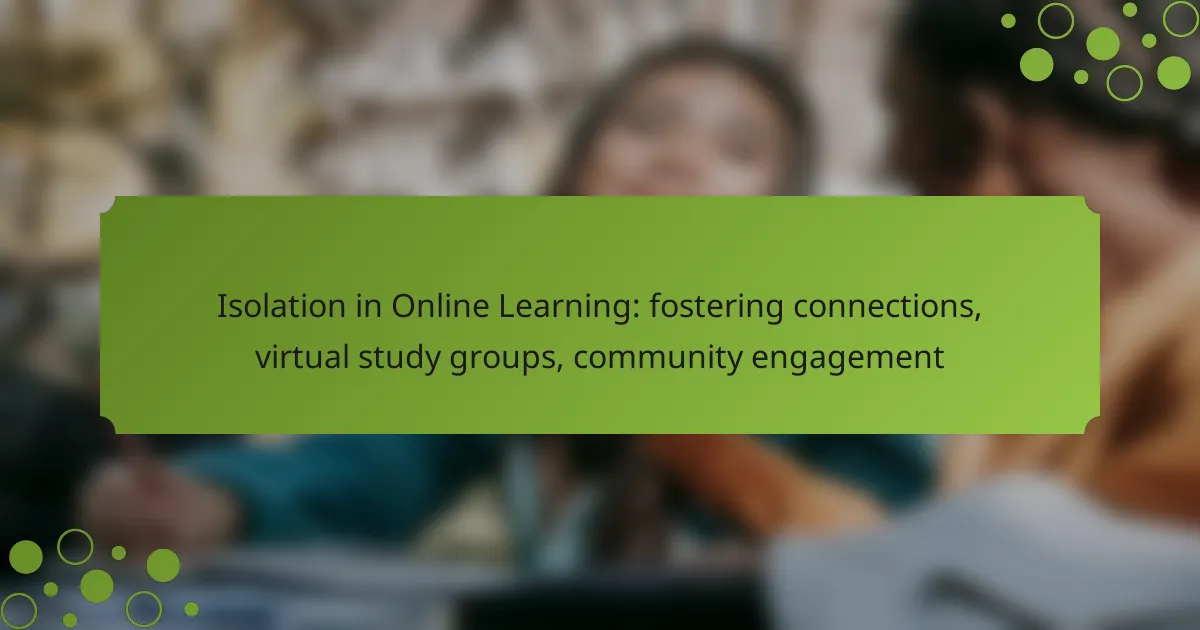
Isolation in online learning can be mitigated by fostering connections among students through intentional engagement and collaboration. By utilizing digital platforms for virtual study groups and community involvement, learners can create a supportive environment that enhances motivation and academic success. Building relationships in this setting not only enriches the educational experience but also helps combat feelings of loneliness often associated with remote learning.
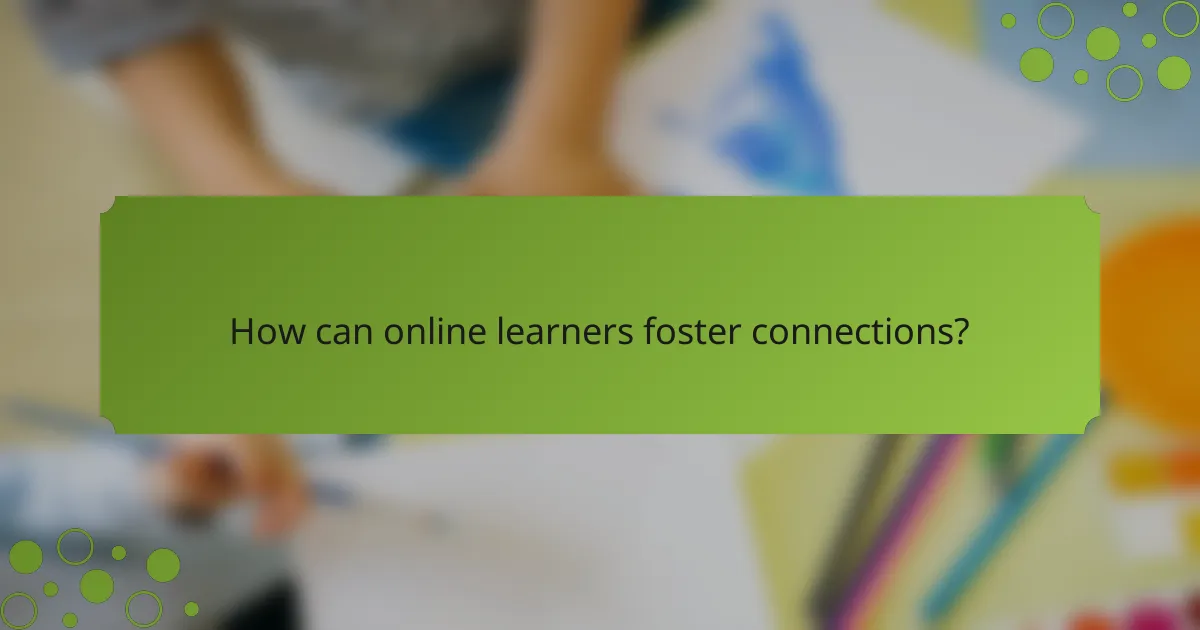
How can online learners foster connections?
Online learners can foster connections by actively engaging with peers through various digital platforms and communities. Building relationships in a virtual environment requires intentional efforts to communicate, collaborate, and participate in shared interests.
Utilizing social media platforms
Social media platforms like Facebook, Twitter, and LinkedIn offer opportunities for online learners to connect with classmates and professionals. Joining groups related to specific courses or fields of study can facilitate discussions and networking.
Consider creating or participating in study groups on these platforms. Sharing resources, asking questions, and providing support can enhance the learning experience and build a sense of community.
Participating in online forums
Online forums such as Reddit, Quora, or specialized educational sites allow learners to engage in discussions and seek advice. These platforms often have dedicated sections for various subjects, making it easier to find relevant conversations.
When participating, be sure to contribute thoughtfully and respect differing opinions. Regular engagement can lead to meaningful connections with others who share similar academic interests.
Engaging in virtual events
Virtual events, including webinars, workshops, and conferences, provide excellent opportunities for networking. Attending these events allows learners to interact with speakers and fellow attendees, fostering connections beyond the classroom.
To maximize engagement, prepare questions in advance and actively participate in discussions. Follow up with new contacts after the event to maintain the connection and explore collaborative opportunities.
Joining dedicated online communities
Joining dedicated online communities, such as Discord servers or Slack channels focused on education, can enhance the learning experience. These spaces often provide real-time communication and collaboration on projects or study sessions.
Look for communities that align with your interests or academic goals. Actively participating in discussions and sharing insights can help you build lasting relationships with peers who are on similar learning journeys.

What are effective virtual study group strategies?
Effective virtual study group strategies focus on fostering collaboration and maintaining engagement among participants. By implementing structured approaches, students can enhance their learning experience and build connections despite physical distance.
Setting clear goals and objectives
Establishing clear goals and objectives is crucial for a successful virtual study group. Each session should have specific outcomes, such as mastering a particular topic or preparing for an upcoming exam. This clarity helps keep members focused and accountable.
Consider using the SMART criteria—Specific, Measurable, Achievable, Relevant, and Time-bound—to formulate these goals. For example, instead of a vague goal like “study math,” aim for “complete chapters 3 and 4 and solve ten practice problems by next week.”
Using collaborative tools like Zoom
Utilizing collaborative tools such as Zoom can significantly enhance the virtual study group experience. These platforms allow for real-time communication, screen sharing, and interactive discussions, making it easier to collaborate on projects or review materials together.
In addition to Zoom, consider using tools like Google Docs for collaborative note-taking or Trello for project management. These resources can help streamline the workflow and ensure everyone is on the same page.
Scheduling regular meetings
Regularly scheduled meetings are essential for maintaining momentum in a virtual study group. Aim for weekly or bi-weekly sessions to create a consistent routine that encourages participation and accountability among members.
When scheduling, consider using a shared calendar tool to find mutually convenient times. Additionally, rotating the responsibility of leading sessions can keep engagement high and allow different members to contribute their strengths.
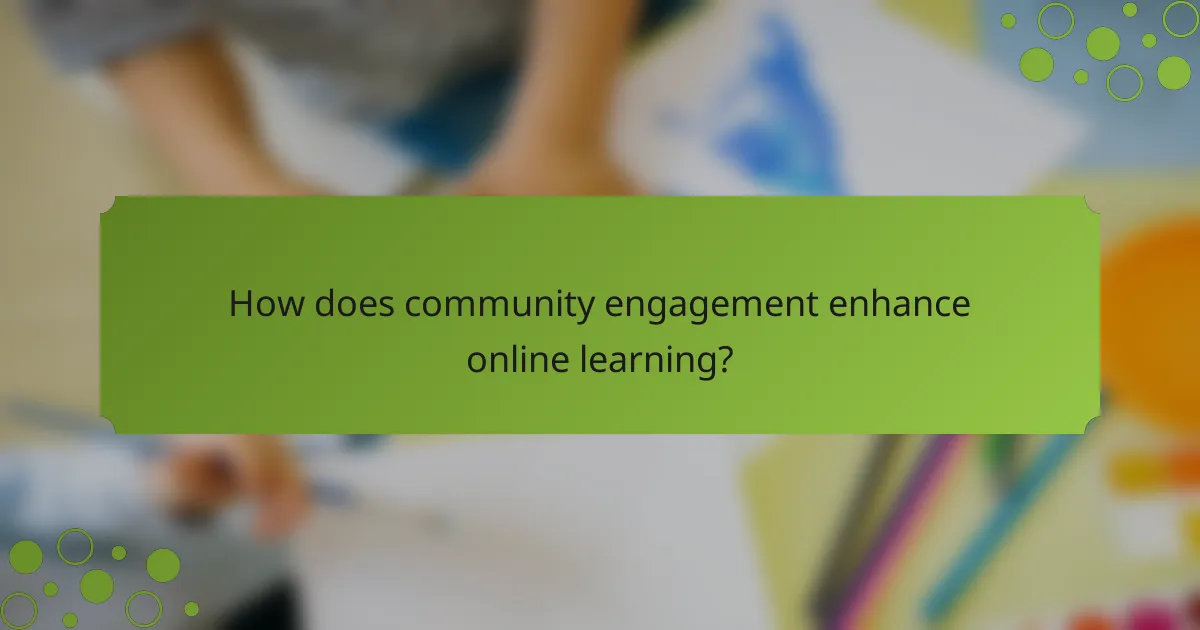
How does community engagement enhance online learning?
Community engagement significantly enhances online learning by fostering connections among students, which can lead to improved motivation and academic performance. When learners feel part of a community, they are more likely to participate actively and support one another in their educational journeys.
Building a sense of belonging
Creating a sense of belonging in online learning environments is crucial for student retention and satisfaction. Engaging in group discussions, participating in forums, and collaborating on projects can help students feel connected to their peers and instructors.
To cultivate this sense of belonging, institutions can implement welcome activities, such as icebreaker sessions or virtual meet-and-greets, that encourage students to share their backgrounds and interests. This initial connection can set the tone for a supportive learning atmosphere.
Encouraging peer support
Peer support is vital in online learning, as it provides students with additional resources and encouragement. When students collaborate, they can share insights, clarify doubts, and motivate each other to stay on track with their studies.
Establishing virtual study groups or buddy systems can facilitate this peer support. For example, students can be paired based on similar subjects or interests, allowing them to work together effectively and build lasting relationships.
Facilitating knowledge sharing
Knowledge sharing among students enhances the learning experience by allowing diverse perspectives and expertise to emerge. When learners exchange ideas and resources, they deepen their understanding of the subject matter and develop critical thinking skills.
Creating platforms for knowledge sharing, such as discussion boards or collaborative projects, can encourage students to contribute their insights. Additionally, instructors can promote this practice by assigning group tasks that require input from all members, ensuring everyone has a voice in the learning process.
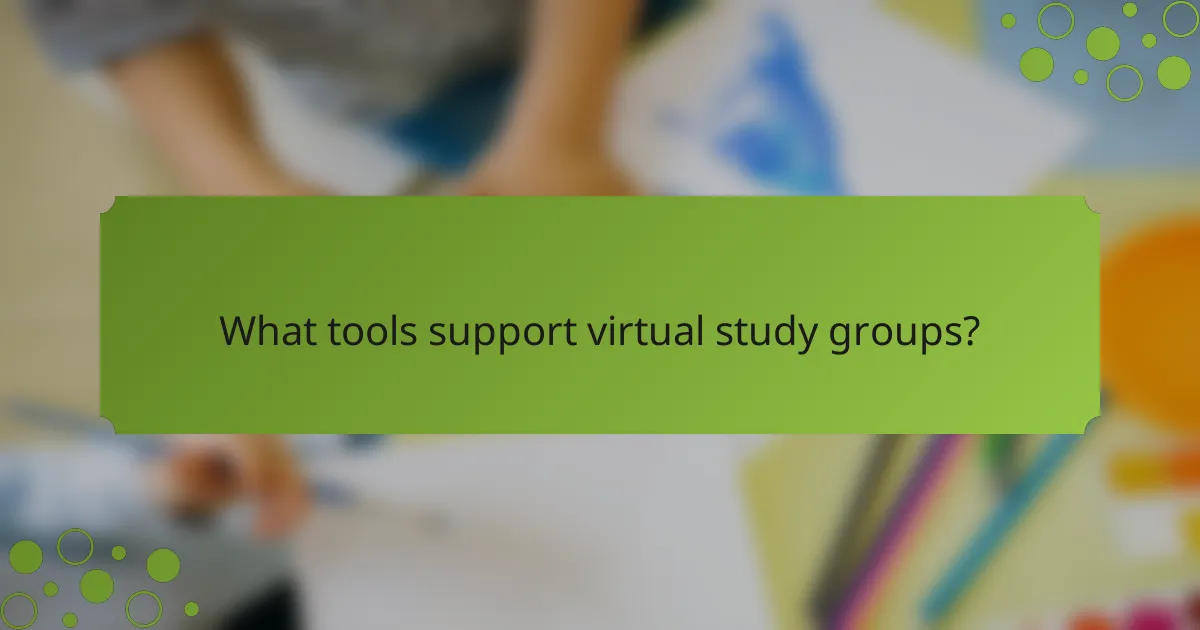
What tools support virtual study groups?
Several tools can effectively support virtual study groups by enhancing communication, collaboration, and organization. Utilizing the right platforms can help foster connections among students and create a more engaging online learning environment.
Google Meet for video conferencing
Google Meet is a widely used platform for video conferencing that allows students to connect face-to-face in a virtual setting. It supports high-quality video and audio, making it suitable for discussions, presentations, and group study sessions.
To set up a meeting, simply create a link and share it with group members. Google Meet also integrates with Google Calendar, making it easy to schedule and manage study sessions. A key tip is to use features like screen sharing to enhance collaboration on projects or study materials.
Trello for task management
Trello is an effective tool for task management that helps virtual study groups organize their projects and assignments visually. Users can create boards, lists, and cards to track tasks, deadlines, and responsibilities, ensuring everyone stays on the same page.
To maximize Trello’s potential, establish clear categories for different subjects or projects and assign tasks to specific group members. This promotes accountability and helps manage workloads effectively. Regularly updating the board can prevent confusion and keep the group focused on their goals.
Slack for communication
Slack is a robust communication platform that facilitates real-time messaging and collaboration among study group members. It allows users to create channels for specific topics, making it easy to keep discussions organized and relevant.
Consider using Slack for quick questions, sharing resources, or discussing assignments. Integrating apps like Google Drive can streamline file sharing, while reminders can help keep the group on track. A common pitfall is letting conversations become too scattered; encourage members to stay within designated channels for focused discussions.

What are the prerequisites for effective online collaboration?
Effective online collaboration requires clear communication, mutual respect, and a shared understanding of goals among participants. Establishing a supportive environment fosters connections and enhances the learning experience.
Establishing ground rules
Setting ground rules is essential for successful online collaboration. These rules should cover communication protocols, participation expectations, and conflict resolution strategies. For example, participants might agree to respond to messages within a specific timeframe or to use respectful language during discussions.
Clear ground rules help create a safe space for sharing ideas and encourage active engagement. Regularly revisiting these rules can ensure that everyone remains aligned and committed to the collaborative process.
Ensuring technology access
Access to reliable technology is crucial for effective online collaboration. Participants should have the necessary devices, software, and internet connectivity to engage fully in virtual study groups. This might involve checking compatibility with platforms like Zoom or Google Meet and ensuring that all members can access shared resources.
Consider providing alternatives for those with limited access, such as recorded sessions or downloadable materials. Offering technical support can also help participants navigate any challenges they encounter, ensuring that everyone can contribute meaningfully to the collaboration.
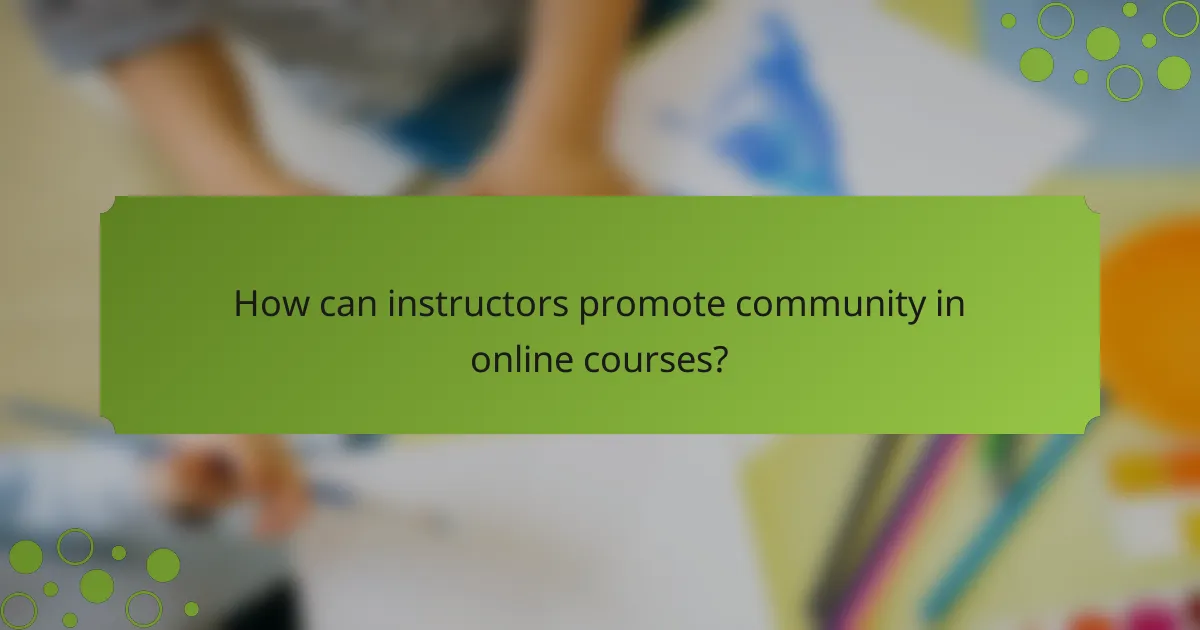
How can instructors promote community in online courses?
Instructors can foster community in online courses by creating interactive environments that encourage collaboration and engagement among students. This can be achieved through various strategies that emphasize communication, shared goals, and social connections.
Encouraging Interaction
To promote community, instructors should facilitate regular interaction among students. This can include discussion forums, group projects, and live Q&A sessions. Utilizing tools like video conferencing can enhance personal connections, making students feel more involved.
Instructors can set specific times for synchronous meetings or discussions, allowing students to engage in real-time. Additionally, encouraging peer feedback on assignments can create a sense of shared responsibility and collaboration.
Creating Virtual Study Groups
Establishing virtual study groups is an effective way to build community. Instructors can organize students into small groups based on interests or course topics, allowing them to collaborate on assignments and share resources. This not only enhances learning but also fosters friendships.
Providing guidelines for group interactions, such as regular check-ins and collaborative tasks, can help maintain engagement. Instructors might also offer incentives for participation, such as extra credit or recognition, to motivate students to join these groups.
Promoting Community Engagement
Community engagement can be enhanced through extracurricular activities that complement the course material. Instructors can organize webinars, guest speaker events, or online workshops that allow students to connect with industry professionals and each other.
Encouraging students to participate in online forums or social media groups related to the course can also strengthen community ties. Instructors should actively participate in these spaces to guide discussions and provide support, reinforcing a sense of belonging.


